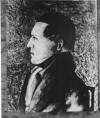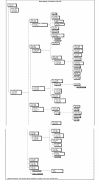SANDFORD CULL COX
12. Sandford Cull3 Cox (Joseph2, John1) was born 1 July 1811, near Richmond in Wayne County, Indiana, and died on 4 October 1877 at Lafayette, Tippecanoe County, Indiana. He married, first, on 12 July 1838, Levina Fleming, who was born on 23 February 1807 and died on 19 August 1838, just over a month after her wedding, apparently of cholera. Sandford married, second, on 27 December 1855 in Lafayette, Charity Elizabeth Davis, his ward. She was born on 22 October 1839 in Virginia, a daughter of Levi Davis, and died on 9 May 1914 in California.
The following summary of Sandford’s life is taken from the sketch of his life published at pages 707-709 in Lewis Publishing Co.'s Biographical Record and Portrait Album of Tippecanoe County, Indiana (1888) [S148], and from a letter written by Sandford’s grandson Joseph S. Cox to his brother Ralph on 1 February 1942 (S145; he says: “my information comes through Grandma Cox, with whom I lived until I was about ten or eleven years old, and from some of Granpa Cox’s stories in ‘Old Settlers’”).
About 1825 [Sandford] came with his parents to Montgomery County, settling near the banks of Sugar Creek. Soon afterward, on a sleety day, when Sandford was about fourteen years of age, he was near a tree that was being cut down by his brother and sister, one chopping on one side and one on the other. The tree fell upon him and so badly crushed his legs that he was confined to the bed a long time, and one limb had finally to be amputated. (S148)
This was supposed to be the first case of major surgery in the State of Indiana; and at that early day there were not to be found in the whole region an accomplished surgeon, good surgical instrument or anaesthetic of any kind. The attendants confronted a terrible task. They placed the sufferer upon a large wooden slab, and after bandaging the part and commencing the work of cutting, they feared to complete the job, not knowing how to take up the arteries until they sent for a physician sixteen miles distant! Twenty-four hours elapsed between the commencement of the operation and the close, all this while the patient being conscious of everything and having no access to any pain-obstunding drug! The cut surface was seared with a hot iron. (S148)
Grandpa Cox's father was one of those that cut down his trees to make farm land. At any rate that was the way Grandpa lost his leg. His folks went to town, 30 miles with the ox team for supplies, and left Grandpa and Charles home to cut down trees while they were gone. Grandpa cut a tree, and as it was about to fall, his brother was in the way, and Grandpa jumped to push the boy out of the way and the tree caught him and pinned him down, breaking both his legs. The little boy could do nothing to help him, but his cries brought a couple of deer hunters who cut down another tree and made a pry to get it off of him. One of them stayed with him and the other walked to town to get the doctor. He met the folks coming home, and then they had to turn around and go back to town to get the doctor. When they got back in about three days, gangrene had started in one leg, and three different amputations were made, the last right up to the hip, before the infection could be stopped. They strapped him on the kitchen table and used the meat saw and butcher knife and a hot iron. He was tough and lived through it. (S145)
Not until eighteen months had expired did the poor boy become able to go around. About a year and a half after his recovery the family removed to the vicinity of Granville, this county. Mr. Cox, realizing that he was a dependent cripple for life, soon became despondent, and withal desperate; his highest and noblest ambitions were crushed; yet, determining to earn his own support in some way, he resorted to the desperate means of stealing away from home on his crutches, and crossing the Wabash River, near Granville, in a hog-trough, so that his parents could not easily find him, for they would not suppose that he could cross the river without the assistance of some one who would tell about it. (S148)
He had had but two years' schooling, and that was of the almost useless pioneer kind; but such was the keenness of his intellect that he picked up a great deal more than the surroundings seemed capable of furnishing. Just across the river he organized and taught a log-cabin school, and it was nine months before the family knew where he was! (S148)
Arriving at the age of twenty years he was appointed, although not of legal age for the place, the first deputy county recorder, to fill the vacancy occasioned by the death of the recorder. He was afterward elected and re-elected recorder for twenty-two years in succession. (S148)
During this period he made his money and studied law. After retiring from the office he entered law practice, in partnership with the late Samuel A. Huff. His early years in the profession were devoted mainly to criminal suits, but subsequently he extended his practice to other branches of the profession. (S148)
During this time he wrote that exceedingly interesting history entitled "Recollections of the Early Settlement of the Wabash Valley" [known informally as “Old Settlers”] . . . . During the war Mr. Cox wrote a number of poems, which afterward were collected and published in book form, under the title, "The Evangelist and Other Poems." These effusions breathe a fervent religious spirit, enjoyable by every Christian. The author was a zealous Methodist all his life. From these publications he realized a little profit. His composition evinces that he had studied history and the classics for a useful purpose. (S148)
Investing his money largely in prairie and swamp lands in the northern part of the State, and in the schemes of various ditching companies which have since led to a successful drainage of that whole section, he came at length to be regarded as a man of considerable property; but the crisis of 1873 came at a time and in such a way as to make him, as the phrase is, "land poor." (S148)
Mr. Cox died of heart disease, and was buried in Greenbush cemetery. In his personal habits and fidelity to principles he was an exemplary man. He was not only a devoted Christian, but a pronounced Abolitionist in the days when such a position ensured a man a great deal of enmity and suspicion. During the winter of 1844-'45, when a large number of pro-slavery ruffians undertook to "clean out" La Fayette, Mr. Cox was one of the few who dared to conceal some of the colored citizens in his cellar. He was also one of the conductors and station agents of the "underground railroad." (S148)
He was a good campaignist and "stump speaker," both on political and social occasions, receiving many invitations to entertainments where he was expected to be the chief wit. His "dry" humor was so characteristic of the man as to be always refreshing. Neither liquor nor tobacco did he use after he came of age. . . . (S148)
Children:
66 i. Joseph Levi4 Cox, b. 23 Mar 1857, Oxford, Ill; m. Catherine (Katie) Sherwood
67 ii. Walter Hallowell Cox, b. 5 Sep 1860, Lafayette, Tippecanoe Co, Ind; m1 Annabelle Reese; m2 Bessie Belle Richardson
68 iii. Sandford Cull Cox, b. 17 Apr 1863, Lafayette, Tippecanoe Co, Ind; m. Virginia Moore
69 iv. John Simpson Cox, b. 5 Feb 1866, White Co, Ind; m. Alice Mary Weaver
v. Paul Fleming Cox, b. 9 Aug 1868, Reynolds, White Co, Indiana; d. 5 Jul 1947, Los Angeles Co, California
vi. Cassie Davis Cox, b. 22 Nov 1871, Lafayette, Tippecanoe Co, Ind; d. 22 Mar 1872, age 4 months, of spotted fever; bu: Lafayette cem (S149)
71 vii. Mary Caroline Cox, b. 4 Feb 1874?, Lafayette, Tippecanoe Co, Ind; m1 Charles B. Tinker; m2 Charles O'Conner
Back to Cox Home Page Back to Joseph Cox

